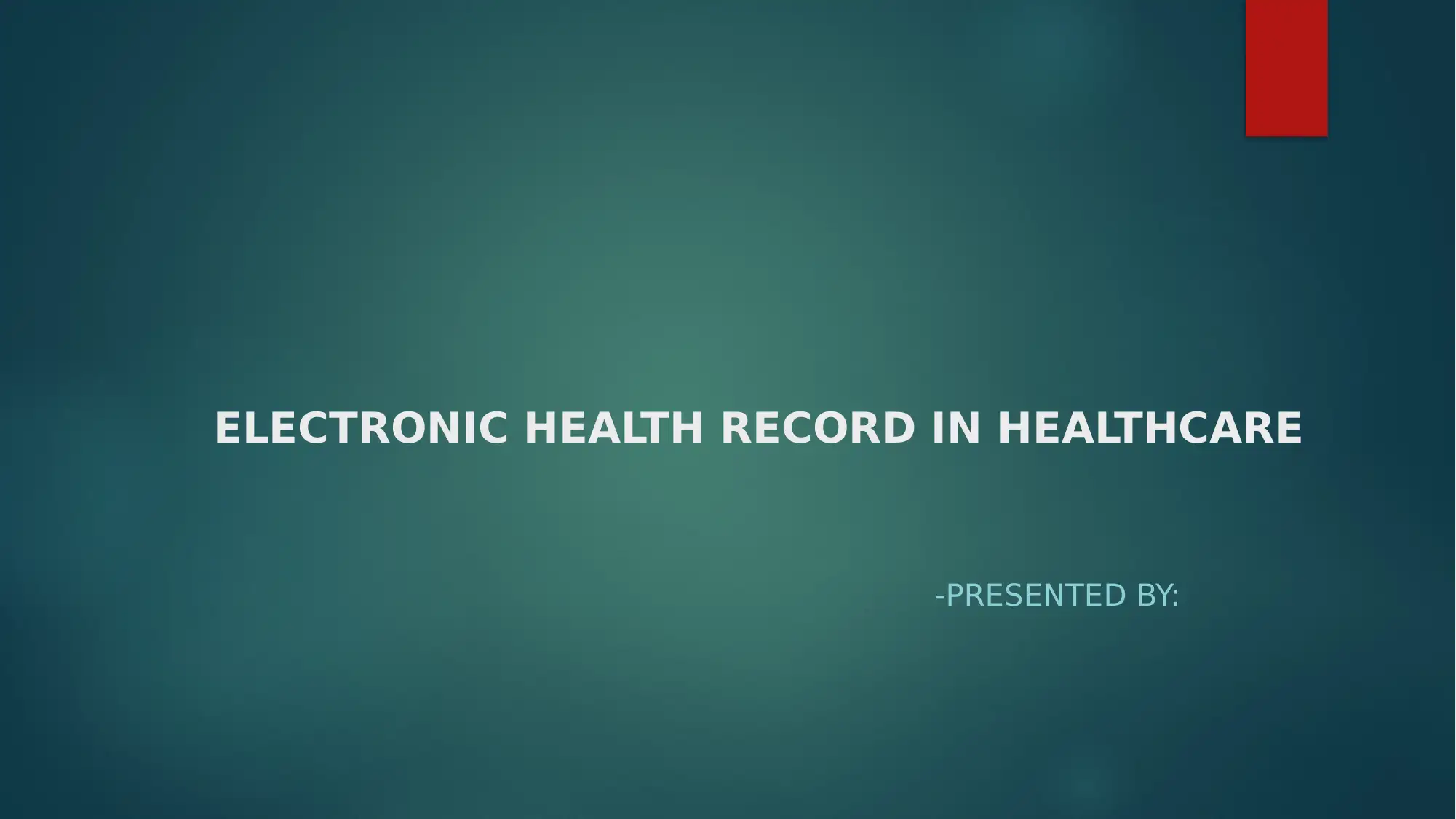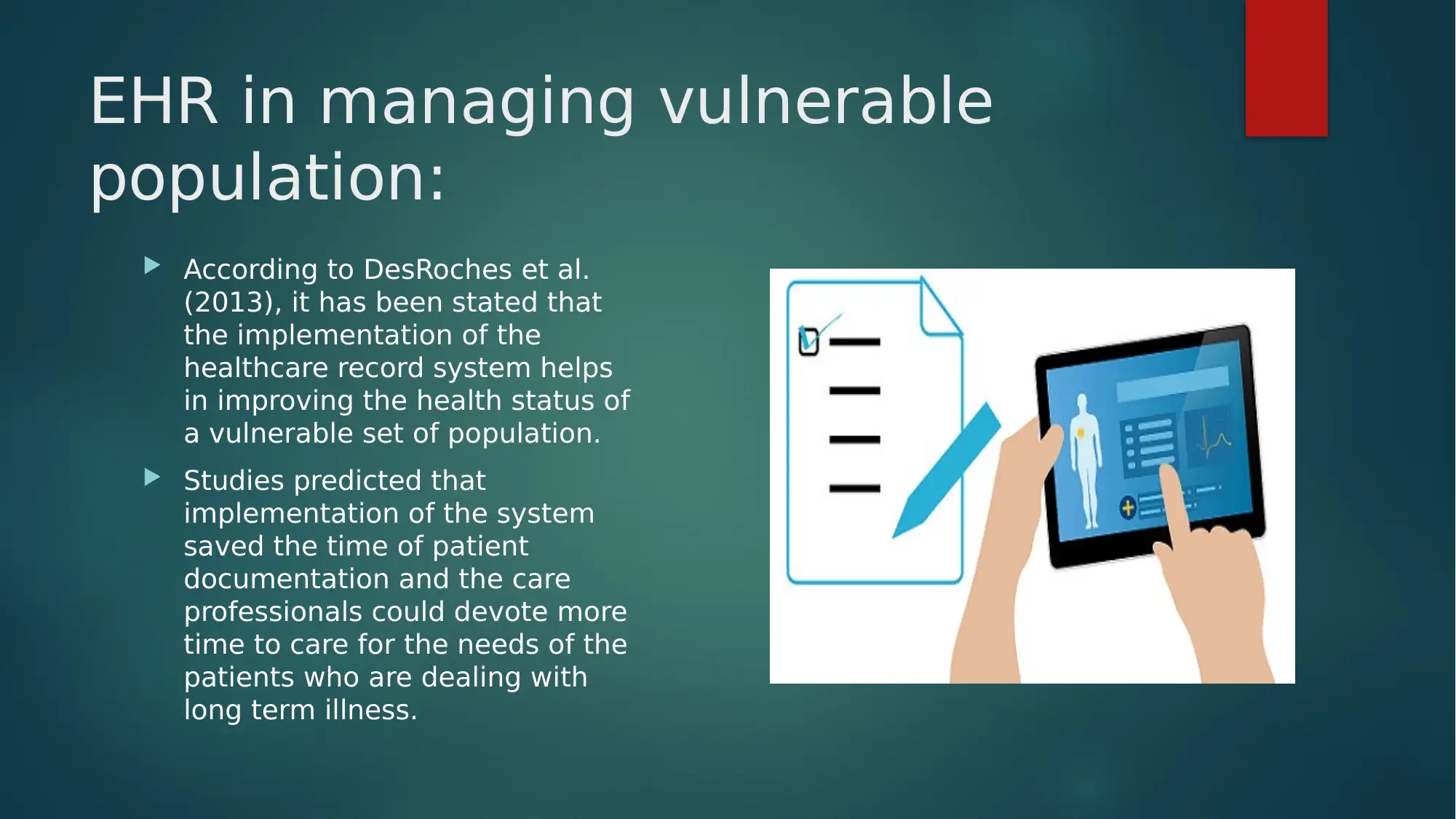Electronic Health Records in Healthcare: A Patient Safety Presentation
VerifiedAdded on 2023/05/28
|13
|800
|405
Presentation
AI Summary
This presentation assesses the role of Electronic Health Records (EHR) in healthcare, focusing on its impact on patient safety and outcomes. It discusses the advantages and disadvantages of EHR systems, including their ethical and legal implications, and their specific relevance to vulnerable populations. The presentation highlights how EHR implementation can automate functions, improve patient outcomes through electronic prescriptions and drug interaction checks, and affect nursing professional practice. It references the Health Information Technology for Economic and Clinical Health Act and includes statistics on EHR adoption rates, emphasizing the potential for increased patient safety, better access to care, and improved outcomes with stringent monitoring and application.

ELECTRONIC HEALTH RECORD IN HEALTHCARE
-PRESENTED BY:
-PRESENTED BY:
Paraphrase This Document
Need a fresh take? Get an instant paraphrase of this document with our AI Paraphraser

Introduction:
The information
management topic that
has been chosen by me
to ideally promote
positive patient outcome
is the system of
electronic health
management.
The information
management topic that
has been chosen by me
to ideally promote
positive patient outcome
is the system of
electronic health
management.

EHR:
An electronic medical record can be
defined as an organized and systematic
collection of the patients medical health
information in the form of a digital
format. The digital records can be shared
across various healthcare settings. The
healthcare records are shared online and
the exchange of information is
maintained through information
networking (Tanner et al. 2015).
The electronic healthcare system also
known as the EHR, has revolutionised
the process of maintain patient record
and documentation in the healthcare
sector
An electronic medical record can be
defined as an organized and systematic
collection of the patients medical health
information in the form of a digital
format. The digital records can be shared
across various healthcare settings. The
healthcare records are shared online and
the exchange of information is
maintained through information
networking (Tanner et al. 2015).
The electronic healthcare system also
known as the EHR, has revolutionised
the process of maintain patient record
and documentation in the healthcare
sector
⊘ This is a preview!⊘
Do you want full access?
Subscribe today to unlock all pages.

Trusted by 1+ million students worldwide

Advantages of EHR:
The advantages of including EHR
within the healthcare sector can be
enumerated as:
It provides organized, appropriate,
updated and complete information
about the patients at different points
of care
It provides an easy access to the
patient records and positively
promotes in the delivery of an
efficient and coordinated care
It ensures patient privacy and secures
the sharing of the patient related
information between the patient and
other related healthcare professionals
The advantages of including EHR
within the healthcare sector can be
enumerated as:
It provides organized, appropriate,
updated and complete information
about the patients at different points
of care
It provides an easy access to the
patient records and positively
promotes in the delivery of an
efficient and coordinated care
It ensures patient privacy and secures
the sharing of the patient related
information between the patient and
other related healthcare professionals
Paraphrase This Document
Need a fresh take? Get an instant paraphrase of this document with our AI Paraphraser

Disadvantages of EHR:
The disadvantages on the other
hand can be enumerated as:
Patient privacy and security
issues
Presentation of inaccurate
information
Promoting unwanted anxiety in
patients
Malpractice in relation to liability
concerns
The disadvantages on the other
hand can be enumerated as:
Patient privacy and security
issues
Presentation of inaccurate
information
Promoting unwanted anxiety in
patients
Malpractice in relation to liability
concerns

EHR and patient outcomes:
The application of EHR facilitates
functions that are automated and
does not require manual
operation. This increasingly helps
in acquiring positive patient
outcomes and ensures added
patient
EHR implementation thus
promotes electronic prescription
for the patients, perform
stringent checks on Drug-Drug
interactions and Drug-allergy
interactions security.
The application of EHR facilitates
functions that are automated and
does not require manual
operation. This increasingly helps
in acquiring positive patient
outcomes and ensures added
patient
EHR implementation thus
promotes electronic prescription
for the patients, perform
stringent checks on Drug-Drug
interactions and Drug-allergy
interactions security.
⊘ This is a preview!⊘
Do you want full access?
Subscribe today to unlock all pages.

Trusted by 1+ million students worldwide

Ethical and Legal implications:
Ethical implication include,
patient raw data to
constructively facilitate public
health research
legal implications involve the
adverse consequences of cyber-
criminal laws on infringing
patient security and privacy
management
Ethical implication include,
patient raw data to
constructively facilitate public
health research
legal implications involve the
adverse consequences of cyber-
criminal laws on infringing
patient security and privacy
management
Paraphrase This Document
Need a fresh take? Get an instant paraphrase of this document with our AI Paraphraser

EHR in managing vulnerable
population:
According to DesRoches et al.
(2013), it has been stated that
the implementation of the
healthcare record system helps
in improving the health status of
a vulnerable set of population.
Studies predicted that
implementation of the system
saved the time of patient
documentation and the care
professionals could devote more
time to care for the needs of the
patients who are dealing with
long term illness.
population:
According to DesRoches et al.
(2013), it has been stated that
the implementation of the
healthcare record system helps
in improving the health status of
a vulnerable set of population.
Studies predicted that
implementation of the system
saved the time of patient
documentation and the care
professionals could devote more
time to care for the needs of the
patients who are dealing with
long term illness.

EHR and professional practice:
The Health Information
Technology for Economic and
Clinical Health Act has
revolutionised the health care
sector with the introduction of
electronic health records.
The implementation has
rendered a positive implication
on the nursing professional
practice (Chen et al., 2018).
Fig: EHR adaption rate in
Australia
Source: (Tanner et
al.,2015)
The Health Information
Technology for Economic and
Clinical Health Act has
revolutionised the health care
sector with the introduction of
electronic health records.
The implementation has
rendered a positive implication
on the nursing professional
practice (Chen et al., 2018).
Fig: EHR adaption rate in
Australia
Source: (Tanner et
al.,2015)
⊘ This is a preview!⊘
Do you want full access?
Subscribe today to unlock all pages.

Trusted by 1+ million students worldwide

Future of healthcare:
It has been estimated that
almost 94% of the healthcare
service providers have stated
that maintenance of electronic
health record system has proved
to be extremely beneficial to
promote quality patient
outcomes (Kwan et al., 2013)
This proves that EHR is the future
of the healthcare department.
It has been estimated that
almost 94% of the healthcare
service providers have stated
that maintenance of electronic
health record system has proved
to be extremely beneficial to
promote quality patient
outcomes (Kwan et al., 2013)
This proves that EHR is the future
of the healthcare department.
Paraphrase This Document
Need a fresh take? Get an instant paraphrase of this document with our AI Paraphraser

Conclusion:
The inclusion of electronic health
record system would facilitate
increased patient safety, better
access to care and positive
patient outcome
However, reinforcement of
stringent monitoring of the
application would promote
quality outcome while dealing
with the vulnerable set of
population.
The inclusion of electronic health
record system would facilitate
increased patient safety, better
access to care and positive
patient outcome
However, reinforcement of
stringent monitoring of the
application would promote
quality outcome while dealing
with the vulnerable set of
population.

References:
Chen, J., Malani, P., & Kullgren, J. (2018). Patient portals: Improving the
health of older adults by increasing use and access. Health affair blogs.
Retrieved
https://www.healthaffairs.org/do/10.1377/hblog20180830.888175/full/.
DesRoches, C. M., Charles, D., Furukawa, M. F., Joshi, M. S., Kralovec, P.,
Mostashari, F., ... & Jha, A. K. (2013). Adoption of electronic health
records grows rapidly, but fewer than half of US hospitals had at least a
basic system in 2012. Health Affairs, 32(8), 1478-1485.
Kwan, J. L., Lo, L., Sampson, M., & Shojania, K. G. (2013). Medication
reconciliation during transitions of care as a patient safety strategy: a
systematic review. Annals of internal medicine, 158(5_Part_2), 397-403.
Tanner, C., Gans, D., White, J., Nath, R., & Pohl, J. (2015). Electronic Health
Records and Patient Safety. Applied clinical informatics, 6(01), 136-147.
Chen, J., Malani, P., & Kullgren, J. (2018). Patient portals: Improving the
health of older adults by increasing use and access. Health affair blogs.
Retrieved
https://www.healthaffairs.org/do/10.1377/hblog20180830.888175/full/.
DesRoches, C. M., Charles, D., Furukawa, M. F., Joshi, M. S., Kralovec, P.,
Mostashari, F., ... & Jha, A. K. (2013). Adoption of electronic health
records grows rapidly, but fewer than half of US hospitals had at least a
basic system in 2012. Health Affairs, 32(8), 1478-1485.
Kwan, J. L., Lo, L., Sampson, M., & Shojania, K. G. (2013). Medication
reconciliation during transitions of care as a patient safety strategy: a
systematic review. Annals of internal medicine, 158(5_Part_2), 397-403.
Tanner, C., Gans, D., White, J., Nath, R., & Pohl, J. (2015). Electronic Health
Records and Patient Safety. Applied clinical informatics, 6(01), 136-147.
⊘ This is a preview!⊘
Do you want full access?
Subscribe today to unlock all pages.

Trusted by 1+ million students worldwide
1 out of 13
Related Documents
Your All-in-One AI-Powered Toolkit for Academic Success.
+13062052269
info@desklib.com
Available 24*7 on WhatsApp / Email
![[object Object]](/_next/static/media/star-bottom.7253800d.svg)
Unlock your academic potential
Copyright © 2020–2025 A2Z Services. All Rights Reserved. Developed and managed by ZUCOL.





